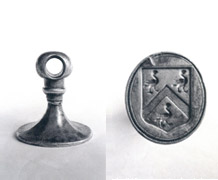
The 350-year-old silver seal matrix was officially declared as treasure at an inquest.
University expertise key in “treasure” inquest
University of Exeter expertise has helped uncover the origins of treasure found by a metal detector on Devon farmland.
Danielle Wootton, Devon Finds Liaison Officer for the Portable Antiquities Scheme, based at the University of Exeter, identified the owner of the 350-year-old silver seal matrix or “stamp”.
It was officially declared as treasure today at an inquest, the first case heard at the new Plymouth Coroners Court following its official opening by Admiral Sir James Burnell-Nugent, the High Sheriff of Devon.
Ms Wootton and Richmond Herald of the College of Arms Clive Cheesman have established it is likely that the silver seal once belonged to the Southcote family of South Devon as it bears the impression of the family coat of arms. The man who found it recognised its importance, and his father gave it to her to analyse.
As the seal matrix is made of more than 10 percent silver and more than 300 years old, the find had to be reported to the Coroner under the Treasure Act 1996. By law, the Coroner must hold an inquest to determine whether the item is officially classed as Treasure. This was done by Plymouth coroner Ian Arrow today.
The finder, who does not wish to be named, and the landowner have donated the seal matrix to Plymouth Museum and Art Gallery, and the item was formally handed over to Curator Fiona Pitt after the inquest.
In her report to the coroner Ms Wootton said: “The birds in the coat of arms are likely to represent coots, a play on the name Southcote. The seal possibly belonged to Thomas Southcote or his brother, John. Thomas Southcote (1622-1664), lived at Buckland Tout Saints and was an MP for Dartmouth. When Thomas died, his estate passed to John, who was appointed as recorder of Totnes by King James II and died in 1701. As the item was produced within the lifetime of Thomas and John, and bears the Southcote coat of arms, it is possible that it belonged to one or both of these men.
Ms Wootton said: “It is not often that we are able to match up an ancient artefact with the person it belonged to, so this is quite unusual and it adds an extra dimension of interest to the seal matrix.”
The finder said: “It was a normal day metal detecting- I'd been finding lots of rubbish and suddenly the seal matrix popped up- it was a nice surprise. I spoke to the farmer who owns the land and we both decided that it was a nice idea to donate the find to Plymouth Museum.
“It is part of our local history and it's nice to know it will be on display for people to see and enjoy. It must have been a lucky day because my father also found a copper alloy medieval dagger guard.”
Coroner Ian Arrow said: ‘It is good to hear that the seal matrix will be donated to Plymouth Museum where it can be properly cared for and enjoyed by the whole community. Both the finder and the landowner are to be commended for responsible reporting of the find and for their generous donation.”
The item will be on display at Plymouth Museum and Art Gallery from March 15.
Further information about the seal matrix can be seen on the Portable Antiquities Scheme website.
Date: 8 March 2016
